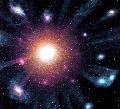A digital time capsule was beamed in a high-powered radio wave in the direction of Gliese 581c, an "Earth-like" planet 20.5 light years away, from Ukraine's National Space Agency on Thursday morning.
The message flew past Mars within four minutes of being broadcast from the gigantic RT-70 radio telescope, but won't reach its destination until 2029.
It includes images of landmarks such as the London Eye and Edinburgh Castle, along with pictures of famous faces including Hillary Clinton and television presenters Richard and Judy.
There are also hundreds of notes written by Bebo members about their lives, ambitions and views of Earth. The messages included in the digital capsule were selected by an online vote.
One reads: "I wish I could be alive to see the day contact between the two worlds is made, I've been born way too early."
Others took a less serious approach, with many using their messages to pay tribute to their favourite celebrities. One message simply reads: "Best thing about Earth. George Sampson", in reference to the Britain's Got Talent winner.
The image of Mr Bush was chosen by Gillian Anderson, the X-Files star who was one of several celebrities involved in the project. She selected a picture of Barack Obama to illustrate goodness.
Pop band McFly chose to send a message praising singer Cheryl Cole's "perfect body".
Oli Madgett, who has been running the A Message From Earth project for Bebo, said he hoped that any aliens living on Gliese 581c would be impressed with the the notes
"We've spent years developing this, and I'm really pleased we've reached this stage," he said.
"Over half a million people have got involved and been really enthusiastic about uploading their messages onto Bebo, which has been great to see.
"I think it has really captured people's imaginations and made them think about our own planet Earth and humanity's impact upon it. I hope whoever's out there is impressed by what Earth has to offer."
Gliese 581c, which was discovered last year, has a radius that is 1.5 times the Earth's. Scientists have estimated that its average temperature is between 0 and 40 C, meaning that water would exist in a liquid state – one of the essential ingredients for life as we know it. source








 E-mail Article
E-mail Article Printer Friendly
Printer Friendly Text-Size
Text-Size 

